In the segmentation of robotics technology, micro-small robots show great potential in many fields such as medical treatment, detection, education and so on with their unique advantages. As a typical representative of micro-small robots, the design concept and technical realization of ant robots are highly innovative and practical value. In this paper, we will have an in-depth discussion on the design features, technical difficulties, application prospects and impact on society of ant robots.
Anthrobot Robot design features
1. Miniaturization
Ant Robot's design pursues the ultimate miniaturization, allowing it to operate in confined spaces, such as precise treatment in human blood vessels or fine probing in small areas.
2. Highly integrated
In order to achieve miniaturization, the design of ant robots requires a high degree of integration, with components such as sensors, controllers, and actuators integrated into a very small volume.
3. Energy efficiency
The design of ant robots emphasizes on energy efficiency to prolong their working time under limited energy conditions and to improve their operational efficiency.
Technical Difficulties
1. Micro-drive Technology
The micro-drive technology is one of the core technologies in the design of ant-robot. How to realize small-size and high-efficiency drives is the main challenge for researchers.
2. Micro-sensor technology
Ant robots need to be equipped with high-precision micro-sensors to sense the external environment, which puts a very high demand on the precision and sensitivity of the sensors.
3. Control and communication
How to realize precise control and stable communication on the basis of miniaturization is a technical challenge to be overcome in the design of ant robot.
Application Prospects
1. Medical Field
Ant-robot has a broad application prospect in the medical field, such as minimally invasive surgery, drug delivery, in-vivo diagnosis, etc., and it is expected to greatly improve the medical service quality and efficiency.
2. Environmental detection
Ant robots can be used for environmental detection, such as underground pipeline detection, disaster site search, etc. Their miniaturization advantage enables them to play a role in complex environments.
3. Education and Research
Ant robots can be used as tools for education and research, helping students and researchers to better understand robotics principles and programming techniques.
Social Impact
1. Driving the Medical Revolution
Ant Robotics in the medical field will promote the development of precision medicine, providing patients with more personalized , minimally invasive treatment programs.
2. Promote environmental protection
The application of ant-type robots in environmental monitoring and management will help improve the efficiency and accuracy of environmental protection.
3. Cultivating Innovative Talents
The research and application of ant robots will stimulate young people's interest in science and technology, and cultivate a generation of talented people with an innovative spirit and practical ability.
Ant-robot design represents the cutting-edge direction of micro-small-scale robotics technology, and its development is not only of great significance to the robotics industry itself, but will also have far-reaching effects on medical care, environmental protection, education and many other fields will have a profound impact. In the face of technological challenges, Chinese researchers should continue to innovate and promote the continuous progress of ant-type robot technology, contributing to the development of society and the well-being of mankind.








